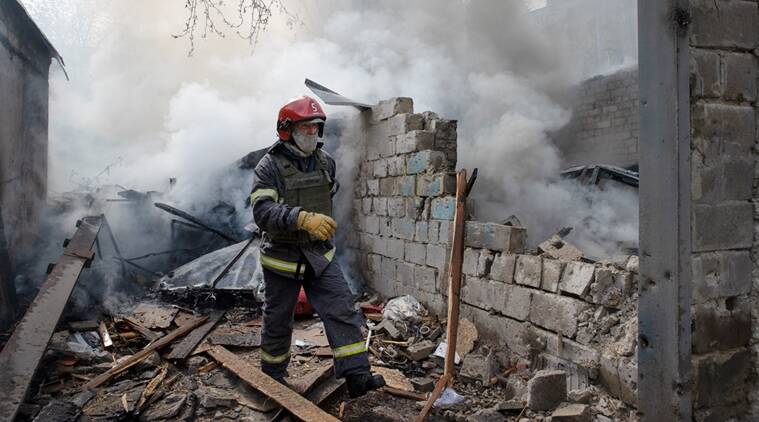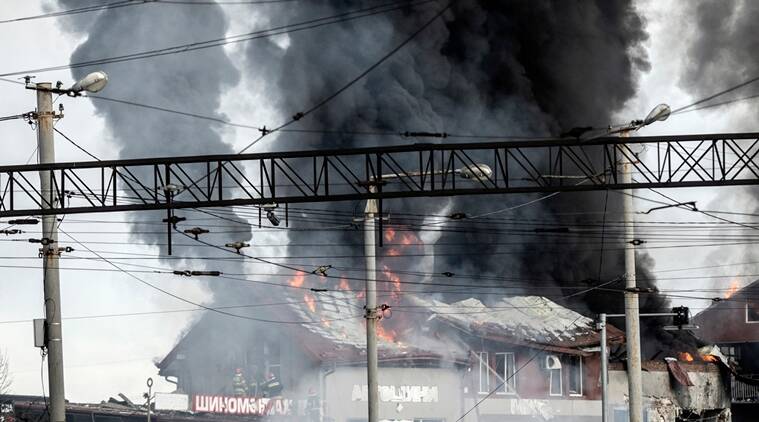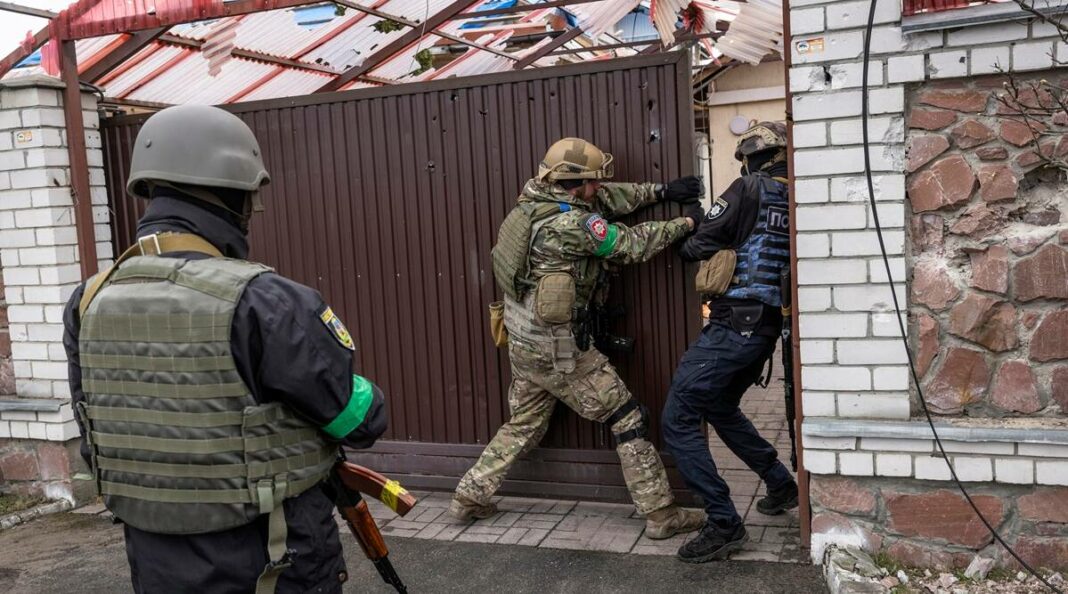Russia plunged into a new chapter of the Ukraine war Tuesday, intent on capturing the eastern part of the country and crushing Ukrainian defenses without the same blunders that badly damaged Russian forces in the conflict’s initial weeks.
“Another phase of this operation is starting now,” Foreign Minister Sergey Lavrov of Russia said, as the Russian Defense Ministry announced that its missile and artillery forces had struck hundreds of Ukrainian military targets overnight.
The strikes mainly hit the eastern region known as the Donbas, Ukraine’s industrial heartland, where pro-Moscow separatists have battled Ukrainian forces since Russia seized Ukraine’s Crimean Peninsula in 2014.
The Donbas has now become the stated territorial objective of Russia’s redeployed invasion force along a front that stretches roughly 300 miles, from an area near the northern city of Kharkiv to the besieged southern port of Mariupol, where die-hard Ukrainian defenders ensconced in a sprawling steel plant have repeatedly defied Russian demands to surrender.
Ukraine’s military said that its forces had repulsed seven Russian thrusts along the front Tuesday, destroying 10 tanks and 18 armoured units in the battles. The claims of both militaries could not be independently verified.
Despite Russian warnings, Ukraine’s Western supporters, led by the United States, are now rushing to send longer-range weapons including howitzers, anti-aircraft systems, anti-ship missiles, armed drones and even tanks — arms that US officials said were designed to thwart the Russian offensive.
 A firefighter at the scene of a Russian attack in Kharkiv, in northeastern Ukraine, on April 19, 2022. (Tyler Hicks/The New York Times)
A firefighter at the scene of a Russian attack in Kharkiv, in northeastern Ukraine, on April 19, 2022. (Tyler Hicks/The New York Times)
Western military experts said the offensive promised to be much more methodical than the blitzlike operation the Kremlin launched February 24 to subjugate Ukraine, which was marked by rapid and ultimately unsuccessful advances of tanks and helicopter assaults deep inside the former Soviet republic.
That miscalculation was compounded by flawed logistics, poor soldier morale, an unexpectedly tenacious Ukrainian resistance and Western-supplied weapons used to devastating effect on Russian armoured vehicles, upending Russia’s hopes for a quick victory and forcing its military to retreat and regroup.
Now, instead of lightning attacks from the Russian front lines, Moscow’s forces, focusing on taking the Donbas, have increased their long-range artillery barrages and sent small detachments of troops to probe Ukrainian defenders, many entrenched in earthworks established during the Moscow-backed insurgency in the eastern region that began eight years ago.
The Pentagon estimated that Russia now has about 75 battalion tactical groups in Ukraine, each with roughly 1,000 troops. It also has tens of thousands more troops in reserve north of Ukraine who are being resupplied and readied to join the fight, US officials said.
But the underlying weaknesses in Russia’s invasion force that have been exposed so far in the conflict have not necessarily gone away, military analysts said. And even with a more deliberate and cautious approach by Russia and its bigger, more powerful army, they said, the outcome in Ukraine remains unclear at best.
Some US military specialists said the Russian reinforcements pouring in — including Russian mercenaries, conscripts and regular troops pulled from the country’s far east and Georgia — are deficient. They have not trained together and their combat readiness is low, officials said.
Moreover, it will take time to regroup and redeploy the battered units that retreated from the north. Some will be replenished and sent back to the fight. But others are so spent that their remaining pieces will be patched together into one new unit with commanders hoping for the best in battle.
As these Russian forces push west to seize more territory, they will extend their supply lines and could confront the same logistics shortfalls that bedevilled them before.
 Smoke rises from the scene of a missile strike in Lviv, Ukraine, on April 18, 2022. (Finbarr O’Reilly/The New York Times)
Smoke rises from the scene of a missile strike in Lviv, Ukraine, on April 18, 2022. (Finbarr O’Reilly/The New York Times)
“The vehicles are still poorly maintained; troop morale will remain low,” said Maj. Gen. Michael S. Repass, a former commander of US Special Operations forces in Europe who has been involved with Ukrainian defense matters since 2016.
“The outcome hinges on who can reconstitute effective forces faster than the other,” Repass said. “Fresh faces from elsewhere in Russia aren’t going to be much use as replacements unless they are combat-ready when they show up.”
Russia’s battlefield mistakes have cost Moscow dearly so far. The number of Russian military losses in the war so far remains unknown, although Western intelligence agencies estimate 7,000 to 10,000 killed and 20,000 to 30,000 wounded. Thousands more have been captured or are missing.
Outgunned and outnumbered, Ukraine has also had steep military losses, although the government has declined to offer specific figures even to US officials. US intelligence agencies estimate 5,500 to 11,000 killed and more than 18,000 wounded, but the wide range indicates the uncertainty in the figures.
Punctuated by Russia’s indiscriminate aerial bombardments, the invasion has left thousands of civilians dead or wounded, caused Europe’s worst refugee crisis since World War II, deeply isolated Russia economically because of Western sanctions and turned President Vladimir Putin of Russia into a pariah who has been described as a war criminal in the United States and Europe.
While there have not yet been any large offensives in the Donbas region, the Ukrainian Ministry of Defense said in a statement Tuesday that Russian forces were laying the groundwork for a future push: More surface-to-air missile systems have been shuttled to the front to protect important positions and more artillery positions have appeared.
At this point in the war, it is clear that long-range weapons that can fire beyond sight of their targets, such as howitzers and multiple launch rocket systems, have proved important when holding and taking territory.
So far, Russia’s new campaign in the Donbas appears to rely heavily on those weapons, as does Ukraine’s defense.
Strikes across Ukraine over the past several days had signaled a new escalation: In Kharkiv, for instance, Russian artillery slammed into a frequently shelled residential area Tuesday, killing at least three people. That strike followed days of blistering rocket and artillery attacks into what had been relatively unscathed parts of the city, Ukraine’s second largest.
Other urban centers like Zaporizhzhia in southern-central Ukraine, Lviv in the far west and Kyiv, the capital in the north, were hit with cruise missiles and artillery fire as Russian forces prepared ground troops for their thrust in the Donbas.
The Donbas battle, on wide-open terrain, will look significantly different from the urban warfare around Kyiv, where the Russian military tried and failed to advance.
This does not mean that Ukraine no longer needs the anti-tank and air-defense systems that have been so effective so far, military analysts said. In addition, the Ukrainians will need powerful arms to enable a counteroffensive of their own.
The $800 million military aid package to Ukraine that President Joe Biden announced last week for the first time included more sophisticated artillery weaponry as well as 200 armored personnel carriers. In a conference call with allies Tuesday, Biden promised more artillery for Ukraine’s forces.
“If deployed in significant numbers, these types of weapons can keep the Russian forces under withering attack, stalling their offensive momentum and potentially dislodging them from dug-in positions,” Lt. Col. Tyson Wetzel of the Air Force and Col. J.B. Barranco of the Marine Corps wrote in an Atlantic Council analysis last week.
“This phase of the conflict will be distinct from phase one, with a greater focus on offensives against dug-in combatants as opposed to Ukrainian defense against a large attacking force,” Wetzel and Barranco wrote. “The campaign is likely to become a bloody war of attrition with limited territorial gains on either side.”
Capturing the besieged city of Mariupol is a key part of the Russian campaign. The fall of the city, which has come to symbolize the death and devastation wrought by the invasion, would allow Russia to complete a land bridge between Russian-held territory and the Crimean Peninsula.
A sprawling Soviet-era steel factory in Mariupol, which its designers have said was built to withstand a nuclear attack, has been sheltering thousands of soldiers and civilians and is the last Ukrainian redoubt there.
Russian commanders said Tuesday that they were beginning their final assault on the factory, the Azovstal steel plant, after the defenders had rejected ultimatums to surrender. A Ukrainian officer in Mariupol, Maj. Sergiy Volyna, wrote on a Telegram channel that “we are ready to fight to the last drop of blood.”
